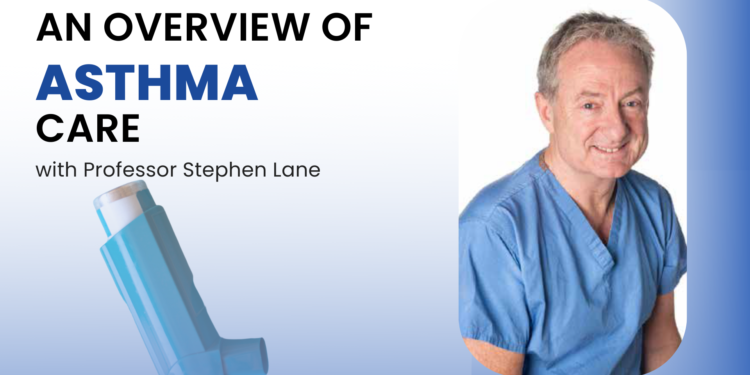Ireland has one of the highest rates of asthma prevalence in the world. It is estimated that approximately 500,000 people in Ireland have a degree of asthma, though usually mild. It is the most common chronic respiratory disease in adults.
Asthma may affect a person all their lives, but it can be managed so effectively that a person has a high quality of life and health. However, many people with asthma live and work with avoidable asthma illness, due to having uncontrolled disease.
This is despite the availability of excellent national and international evidenced-based guidelines and effective, accessible and safe medicines.
We recently spoke to Professor Stephen Lane to understand more about the future of this condition within Ireland.
Professor Lane’s main interest is asthma, related allergies, and COPD.
Professor Lane is Consultant Respiratory Physician at Tallaght University Hospital and Peamount Healthcare and Professor of Respiratory Medicine at Trinity College Dublin. He is Chair of the Clinical Advisory Group of the National Clinical Program for Respiratory Medicine.
Digitalisation of Respiratory Care
Over the past few decades, technology and improvements in artificial intelligence have dramatically changed major sectors of our dayto-day lives, including the field of healthcare. E-health includes a wide range of subdomains, such as wearables, smart-inhalers, portable electronic spirometers, digital stethoscopes, and clinical decision support systems. E-health has been consistently shown to enhance the quality of care, improve adherence to therapy, and allow early detection of worsening in chronic pulmonary diseases.
Professor Lane states, “This is a relatively new field. There are currently a number of devices that can be prescribed to improve adherence and allow doctors to remotely control patients’ compliance particularly in asthma where compliance and adherence to medication is one of the biggest problems we face. This is because asthmatics do not use their inhalers once they are feeling well; this is the most common reason for asthma to be uncontrolled.
“Within the field of digitalisation, there is certainly a way forward whereby you might have an inhaler that records each dose that might be connected to the patient’s phone via Bluetooth technology and the patients can then interrogate that or send it to their doctor. Whilst I do see a role for it, it hasn’t taken off as a standard of care yet but anything that improves adherence to treatment when well is to be welcomed.
“This is, however, a clear opportunity for the future albeit with some challenges. Patients will need to be able to use Bluetooth, use the peak flow meter and the dose counter. Clearly digitalisation is a way forward both for recording lung function like peakflow and oxygen saturations.
New Developments in Asthma Therapy
Anti-interleukin 5 therapy
“This is a new class of treatment that is indicated in patients with severe asthma who are getting frequent exacerbations despite maximal inhaled treatment and whose asthma is associated with high levels of eosinophils on their blood count. Most asthmatics will not need this treatment but for those who do, it is very effective.
“These are revolutionary treatments that are licensed and funded. Currently there are 3: Benralizumab, Mepolizumab and Reslizumab. One key thing to note about these drugs is that Benralizumab, and Mepolizumab are available through the PCRS once they have been prescribed by a physician working within the Severe Asthma Network, a part of the National Clinical Programme for Respiratory Medicine.”
Move away from mono reliever therapy with short acting bronchodilators (SABINA Project) to MART
Professor Lane explains the SABa IN Asthma (SABINA) programme aims to describe the magnitude of SABA (blue inhalers) overuse globally and its impact on clinical asthma outcomes and healthcare utilisation. The SABINA project aims to highlight the dangers of SABA therapy alone. Overuse of SABAs is associated with increased mortality from asthma. Maintenance and Reliever Therapy (MART) with the combination of formoterol and inhaled corticosteroids (ICS) has an established scientific rationale and demonstrated to reduce asthma exacerbations. Reliever treatment is moving toward combining the long acting bronchodilator (LABA) formoteral with an inhaled corticosteroid (ICS) for reliever use in asthma. Formoterol is available in the following combination inhalers e.g Symbicort, Flutiform, Bufomix, DuoResp etc. These treatment treat underlying asthma as well as relieving symptoms. Formoterol is a very safe LABA when used with ICS. LABAs are not to be use alone in asthma, although they have a role in COPD.
He adds, “Pharmacists should always be on the look-out for patients who are using LABAs as a treatment on their own. These type of drugs on their own in an asthmatic context are dangerous.”
“Grass pollen SLIT with Grazax or Oralair, grass pollen molecules, is indicated for the treatment of refractory, seasonal rhinitis which is known to everybody as summer hay fever in May, June and July. We usually start treatment in the autumn, out of season ad continue it for 3 years. It can treat hay fever, can get rid of it for good, and possibly prevent the development of asthma. It is a very effective treatment which is very under prescribed in Ireland.
“House dust mite SLIT is effective for all year round rhinitis in patients who are allergic to HDM It is also indicated for difficult asthma. Acarizax, a HDM product, is now available in Ireland but not yet on the GMS so prices can vary between pharmacies.
“But I would hope that the pharmacists would see an increase in prescriptions for grass pollen and HDM products going forward. Everybody is looking for the instant fix, but it needs to be explained to patients that these treatments are designed for long-term use.
Triple Therapy for patients with COPD, NOT asthma or asthma COPD overla)
“The two main treatments for COPD are LABAs alone or LAMAs (long acting anti muscarinic agents) alone or usually as a LABA- LAMA combination. But despite the LABA- LAMA treatment, patients with COPD continue to have day-to-day symptoms and frequent exacerbations even though they are doing all the right things such as stopping smoking. The next level is to add in an ICS. In selected patients adding an ICS to LAMA and LABA i.e. triple therapy further improves systems, further reduce exacerbations, but the most important thing it can do is reduce mortality. When triple therapy comes in the one device this can improve patient adherence (Trelegy), however, many patients prefer twice daily dosing (Trixeo).
“In my view, I would put everybody eligible patient with COPD on triple treatment, as there are studies showing monotherapy with a LAMA is not as good as dual therapy with LABA-LAMA which in turn is not as good asas good as triple therapy.”
What do pharmacists need to know about these?
• Be aware of move from SABAs to MART therapy
• Monitor how many SABA cannisters a patient with asthma is collecting. More than 3 year indicates poorly controlled asthma
• Be aware of new triple therapies in COPD
• Be aware of increasing use of SLIT for rhinitis and asthma
• Be aware of new monoclonal anti=IL5 treatments for asthma which are now given in the community via the High Tech Scheme
Read the full magazine: September IPN
Read our Latest News










